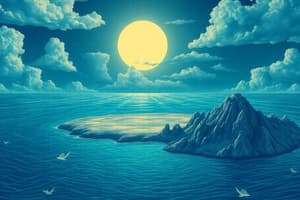Podcast
Questions and Answers
Which of the following statements about sponges is NOT true?
Which of the following statements about sponges is NOT true?
- Sponges are the simplest invertebrate animals.
- Sponges are multicellular and have tissues and organs. (correct)
- Sponges play a role in cleaning the oceans by filtering out bacteria and plankton.
- Sponges can reproduce both sexually and asexually.
What is the primary function of the flagella in sponges?
What is the primary function of the flagella in sponges?
- Movement
- Reproduction
- Secretion of enzymes for digestion
- Filtering water and capturing food (correct)
Which type of sponge is characterized by having silica spicules for support?
Which type of sponge is characterized by having silica spicules for support?
- Calcareous sponges
- Glass sponges (correct)
- Demosponges
- All of the above
What is the name of the elastic fibers found in demosponges?
What is the name of the elastic fibers found in demosponges?
Which of the following is NOT a characteristic of cnidarians?
Which of the following is NOT a characteristic of cnidarians?
What are the two main body forms found in cnidarians?
What are the two main body forms found in cnidarians?
Which of the following is an example of a colonial cnidarian?
Which of the following is an example of a colonial cnidarian?
What distinguishes corals that build reefs from those that do not?
What distinguishes corals that build reefs from those that do not?
Which type of coral builds reefs?
Which type of coral builds reefs?
What is the primary component of a stony coral's skeleton?
What is the primary component of a stony coral's skeleton?
Which of the following is an example of a soft coral?
Which of the following is an example of a soft coral?
What is the primary characteristic that differentiates hydrocorals from true corals?
What is the primary characteristic that differentiates hydrocorals from true corals?
What is the function of the gas-filled float in the Siphonophora (Man of War)?
What is the function of the gas-filled float in the Siphonophora (Man of War)?
Flashcards
Phylum Porifera
Phylum Porifera
A phylum of simple invertebrate animals known as sponges, primarily found in marine environments.
Sponges
Sponges
Multicellular organisms in Phylum Porifera that have porous bodies and no true tissues or organs.
Habitat for marine organisms
Habitat for marine organisms
Sponges provide shelter and food for various marine life due to their unique structure.
Reproduction in sponges
Reproduction in sponges
Signup and view all the flashcards
Calcareous sponges
Calcareous sponges
Signup and view all the flashcards
Phylum Cnidaria
Phylum Cnidaria
Signup and view all the flashcards
Body types of Cnidaria
Body types of Cnidaria
Signup and view all the flashcards
Radial symmetry
Radial symmetry
Signup and view all the flashcards
Stony Coral
Stony Coral
Signup and view all the flashcards
Soft Coral
Soft Coral
Signup and view all the flashcards
Hydrocoral
Hydrocoral
Signup and view all the flashcards
Siphonophora
Siphonophora
Signup and view all the flashcards
Box Jellyfish
Box Jellyfish
Signup and view all the flashcards
Study Notes
Atolls
- Atolls are ring-shaped coral islands
- Feature a lagoon in the center
- Formed from coral reefs growing up from a submerged volcano
- Have a reef flat, back reef, and reef front/fore reef
- Parts of an atoll include a lagoon, back reef, reef flat, reef front, and shoreline
Animal Phyla: Porifera & Cnidaria
- Porifera (Sponges):
- Simplest invertebrates (lack a backbone)
- Mostly marine; some freshwater
- Bodies have pores, hence the name "Porifera"
- Organized at a cellular level, without tissues or organs
- Pump large volumes of water through pores (up to 20,000 times their volume) to feed on bacteria and plankton
- Digestion occurs in amebocytes
- Sponges serve as habitat for many marine organisms
- Reproduction can be sexual or asexual
- Asexual: external buds, internal gemmules
- Sexual: broadcast gametes into the water; meroplanktonic larvae settle into sessile adults
- Three types:
- Calcareous – with supporting spicules
- Glass sponges – silica spicules, found in great depth
- Demosponges – elastic fibers (spongin); used as commercial sponges
- Cnidaria (Jellyfish, Anemones, and Corals):
- Two tissue layers (epidermis, gastrodermis)
- Nerve net and stinging capsules (nematocysts)
- Radial symmetry with two body types: polyp (attached) and medusa (free-floating)
- Corals can live as a free-floating polyp or build colonies into reefs (not all build reefs)
- Coral types:
- Stony – hermatypic reef builders; calcium carbonate body
- Soft – tentacles; do not build reefs; keratin bodies
- Hydrocoral – resemble anemones; powerful neumatocysts; cause skin irritation (fire coral)
Animal Kingdom Numerical Distribution
- 173,000 Porifera
- 43,000 Cnidaria
- 4,500 Vertebrates (4%)
- 774,000 mammals (>1%)
- 79% Insects
- 17% Invertebrates
Studying That Suits You
Use AI to generate personalized quizzes and flashcards to suit your learning preferences.


